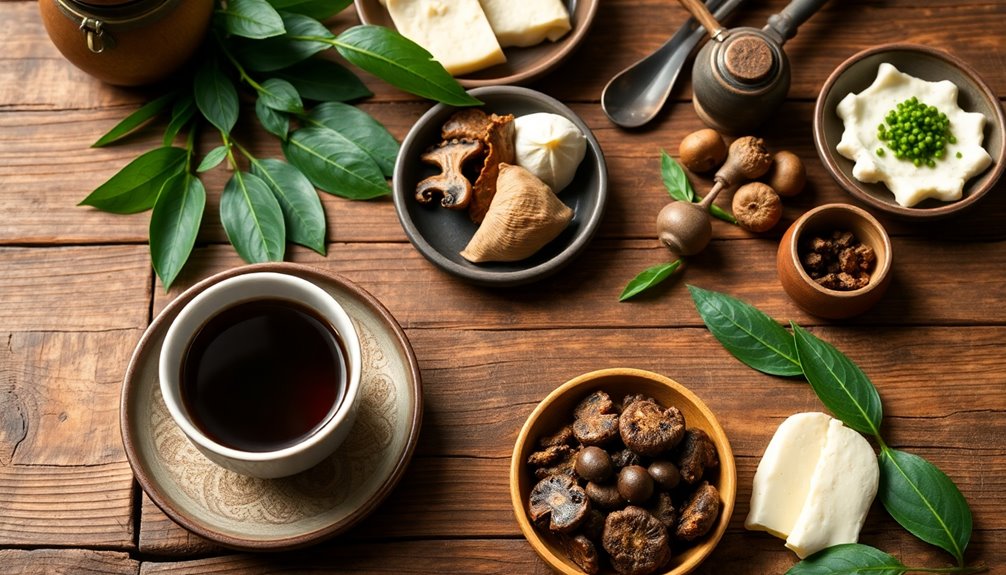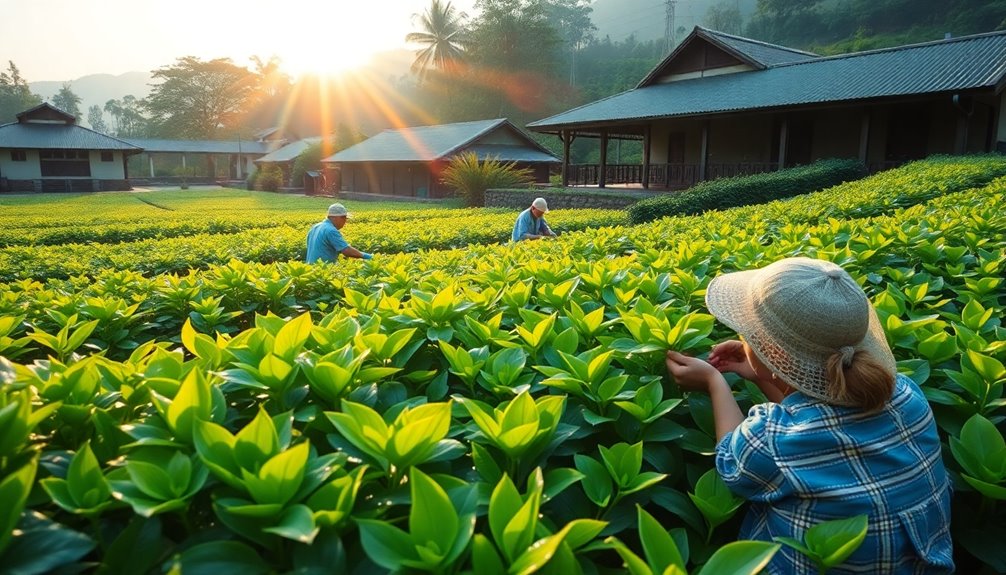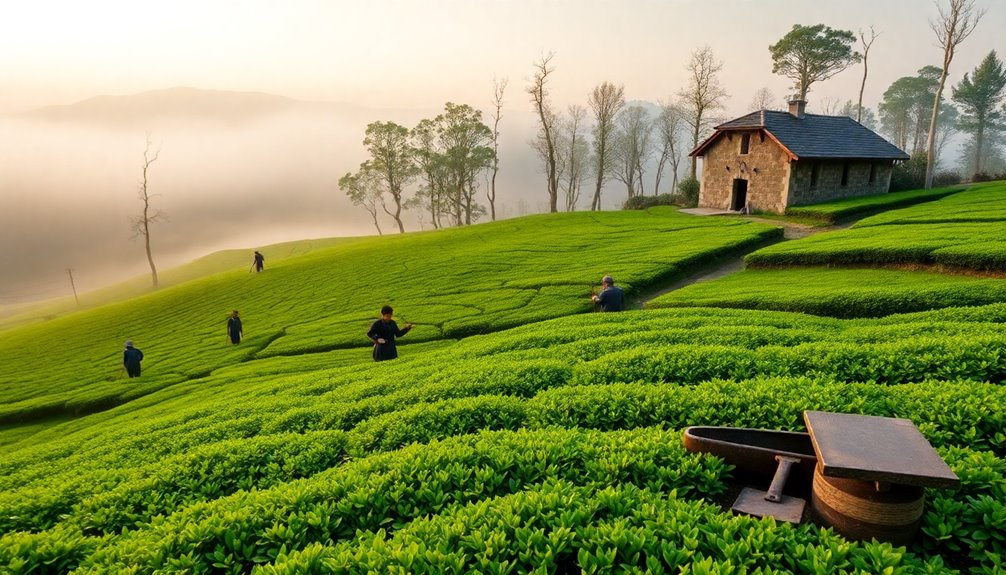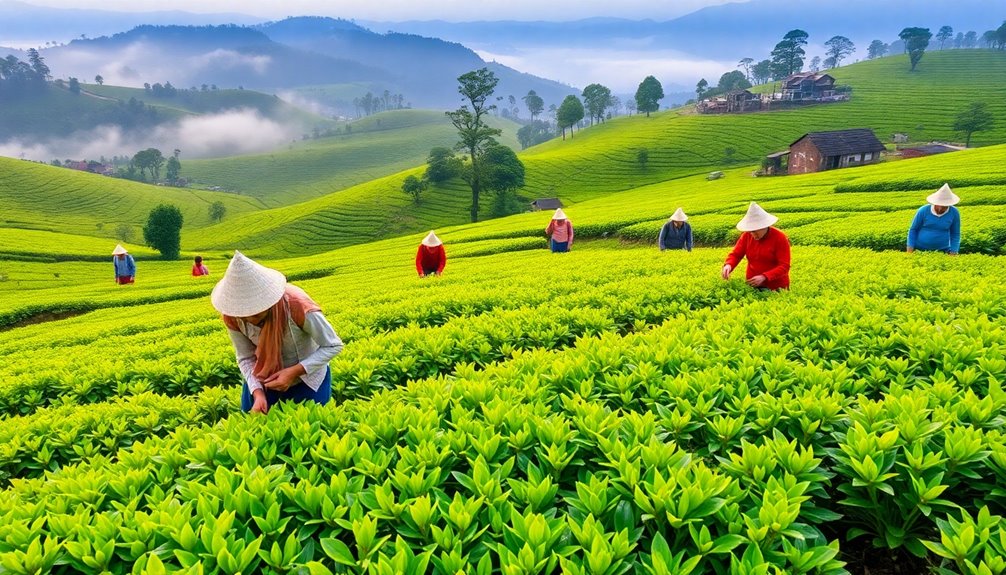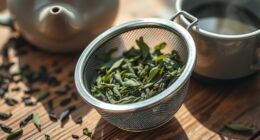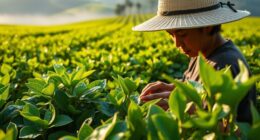When it comes to seasonal tea harvests, timing really matters! Picking tea leaves at just the right moment gives you the best flavors. The first flush in spring, from early April to June, creates sweet and mild teas packed with nutrients. Summer's harvest can be more bitter, while autumn brings creamy flavors. Each season has its own special taste, shaped by climate and weather. Unique conditions, like rainfall and sunshine, also play a big role in how the tea tastes. If you're curious about how these factors blend together to create your favorite cup, there's so much more to learn!
Key Takeaways
- The first flush (Ichibancha) produces the highest quality teas with superior flavor due to higher nutrient concentration.
- Spring harvests benefit from nutrient absorption during winter, resulting in sweeter and milder flavors in tea.
- Summer and autumn harvests may lack complexity, with summer teas often being bitter and autumn teas having unique textures.
- Climate factors, such as sunlight, temperature, and rainfall, significantly influence tea growth and flavor development.
- Weather variability can disrupt harvest schedules, impacting the quality of the tea produced in different regions.
Introduction
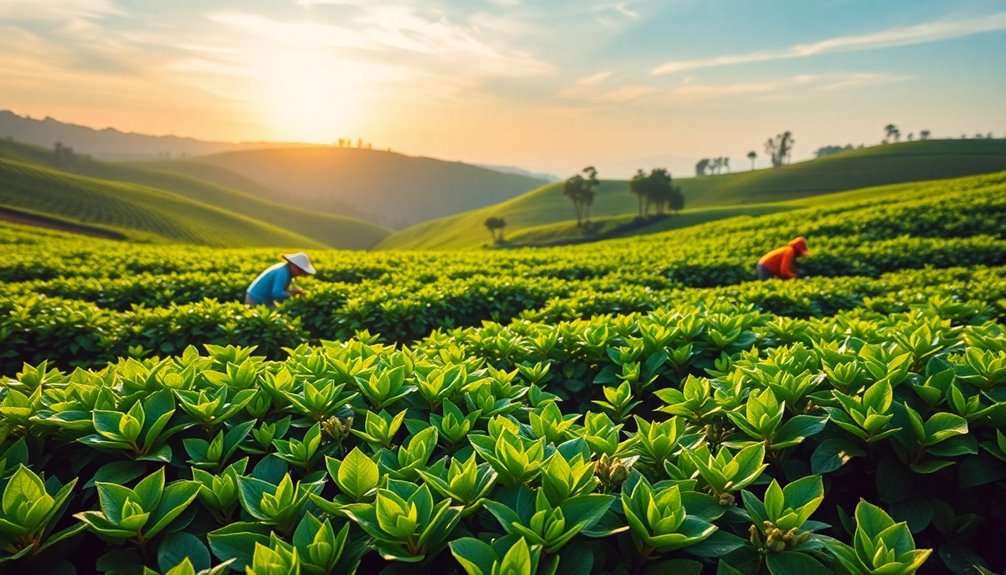
Understanding the nuances of seasonal tea harvests can greatly enhance your appreciation for this beloved beverage.
Have you ever wondered why some teas taste so different? It all starts with the timing of the harvest. The first flush, or Ichibancha, happens from early April to early June. During this time, the tea leaves soak up nutrients after a long winter. This leads to a higher nutrient concentration, making Ichibancha some of the best quality teas!
As the growing seasons continue, other harvests follow. There's Nibancha in June and July, and then Sanbancha from mid-August to mid-September.
Each of these harvests offers unique flavor profiles, shaped by regional climate and weather conditions. You might find that a rainy season can create a different taste than a sunny one.
Harvest Timing Influences Flavor
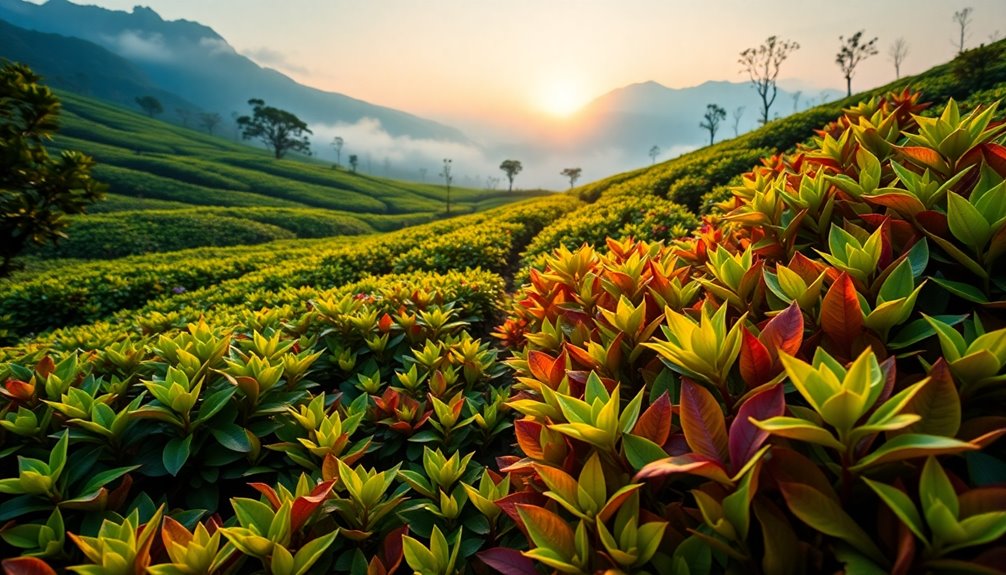
The timing of tea harvests plays a crucial role in shaping the flavor profiles you experience in your cup. When you sip your favorite teas, you might be surprised to learn that spring harvests, especially the first flush, deliver the best flavors!
During this time, tea plants gather nutrients while they rest in winter. That's why spring teas, like Shincha from Japan, taste sweeter and milder. They've more of the special nutrient called L-theanine, which makes them delightful.
In summer, the story changes. Teas harvested then often lack the flavor complexity you find in spring. Rapid plant growth can lead to a bit of bitterness, making them less aromatic.
Autumn's harvest, while sometimes overlooked, produces creamy teas with unique textures. These flavors come from the slower growth and specific weather during that time.
Harvest timing is key! The best leaves for picking are just 3-5 buds, and they must be harvested quickly to keep their quality and flavor.
Harvest Dates Impact Flavor Profiles
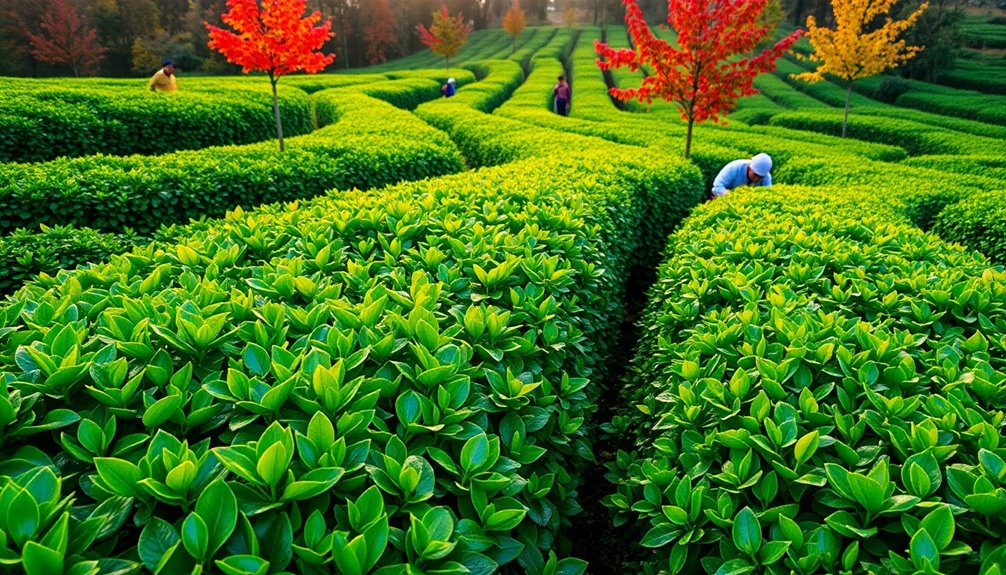
How do specific harvest dates affect the flavor profiles of your favorite teas? The timing of tea harvests plays a crucial role in the taste you enjoy.
For instance, the first flush, or Ichibancha, often produces the highest quality teas. This happens because young leaves soak up nutrients while the plants rest in winter. As a result, these leaves create sweeter and milder flavors, especially in Spring teas like Shincha and Gyokuro.
These spring varieties also have higher L-theanine content, which boosts their delicious flavor and aroma.
When summer rolls around, however, teas can become more bitter and less complex. They're often better for blends or flavored teas.
Autumn harvests can be a bit different. While they mightn't be as aromatic, they can provide creamier textures and milder flavors, especially in oolong teas from places like Taiwan and Guangdong.
The specific harvest dates, like the Ming Qian period in China, truly influence the flavor profiles. Young leaves picked at just the right time yield the most delightful taste.
Climate's Role in Flavor Development
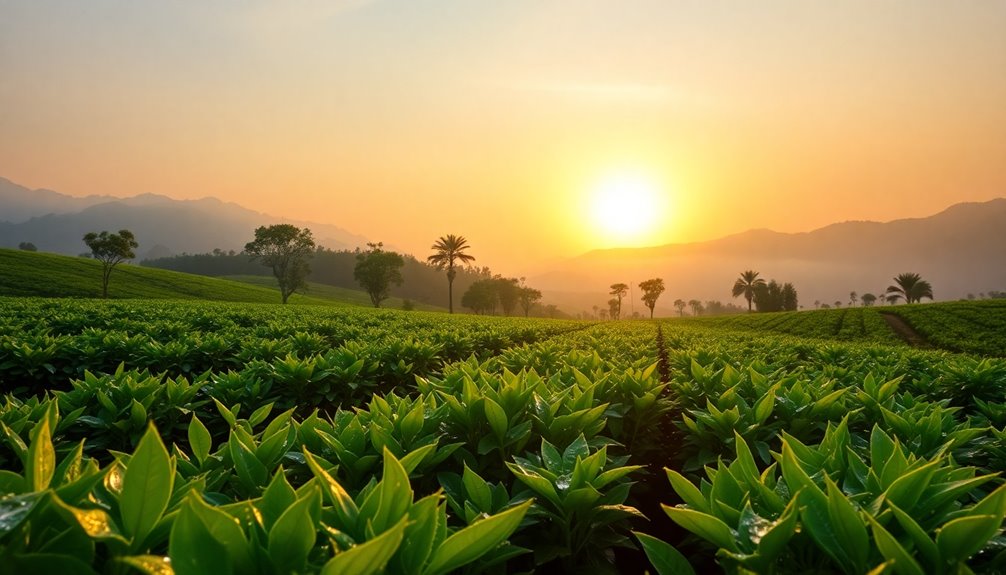
Climate's influence on tea flavor is profound, shaping every sip you take. The growth of tea leaves relies heavily on climate factors like sunlight, temperature, and rainfall. For healthy plants, a minimum of 1,000 mm of rainfall each year is key.
Cooler winter temperatures allow tea plants to rest, storing up nutrients that boost the quality and flavor of spring-harvested teas.
Think about how different regions affect the flavor of your favorite teas. Northern areas often have shorter harvesting seasons than southern ones, leading to unique taste experiences.
Seasonal changes play a big role, too. For instance, spring harvests usually offer sweeter and milder flavors, thanks to a higher concentration of L-theanine.
Don't forget the concept of terroir! This means that local climate, including temperature changes and soil conditions, contributes to the distinct flavor profiles of teas from different locations.
The combination of all these factors makes every cup of tea a little different. So, next time you enjoy your tea, remember how climate shapes its special flavor just for you!
Weather Variability Affects Harvest Quality
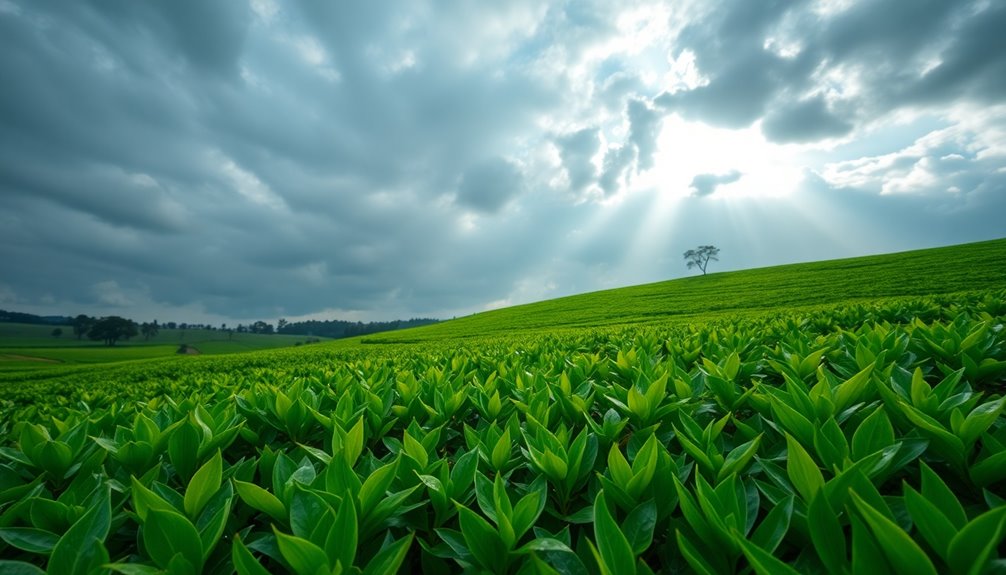
Throughout the growing season, weather variability can dramatically impact the quality of tea harvests. Different weather conditions, like sunlight, temperature, and annual rainfall, are essential for healthy tea plants. For instance, tea plants need at least 1,000 mm of rain each year. Cooler temperatures can slow down growth, especially if it leads to winter dormancy. This affects the nutrient concentration of the leaves you harvest in spring.
You might notice that early harvests often have sweeter and more aromatic flavors. This happens because optimal growing conditions create a special flavor profile. However, if extreme weather events like heavy rainfall or drought occur, they can disrupt the harvest schedule. This disruption often leads to lower harvest quality and yield.
In northern regions, tea plants usually have shorter harvesting seasons due to less favorable weather conditions. In contrast, southern regions enjoy nearly year-round harvesting opportunities.
Whether you're sipping your favorite tea or growing your own, understanding how weather affects harvest quality can deepen your appreciation for this delightful beverage. Embracing these insights makes each cup of tea even more special!
Practical Applications
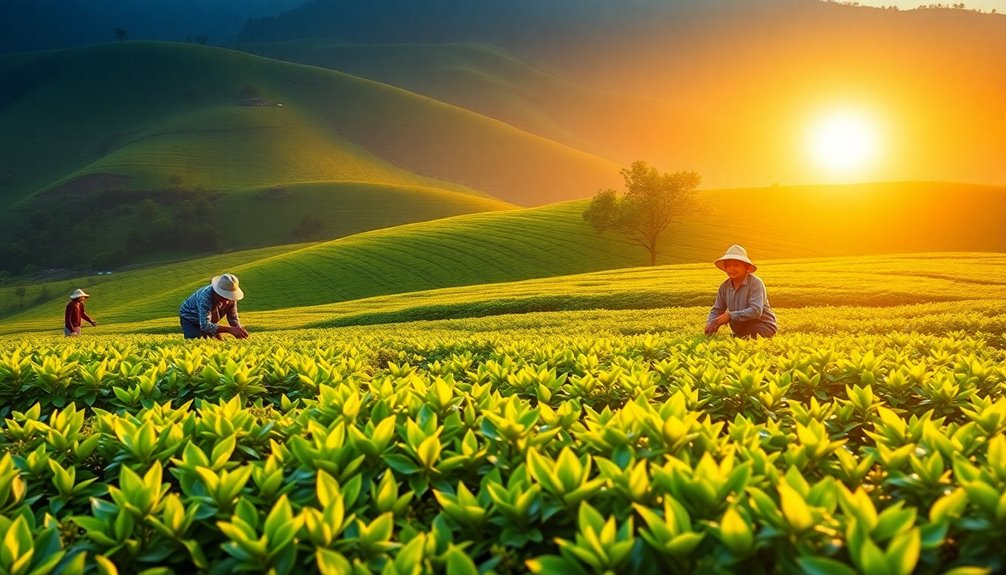
Understanding the seasonal timing of tea harvests can significantly enhance your tea experience. When you know the best times to buy tea, you can choose the highest quality teas available!
For example, the first flush of Darjeeling tea, harvested in March and April, offers delightful floral notes and fruity flavors. This is because the cooler temperatures produce sweet spring teas that are simply irresistible.
If you're looking for high-grade teas like Gyokuro and Shincha, knowing the harvesting timeframe is essential. These teas are picked quickly to maintain their quality, thanks to precise timing in the fields.
On the other hand, summer teas are often mass-produced. They might lack the complexity you'd find in spring teas, making them better suited for flavored blends or affordable options.
Frequently Asked Questions
Which Period of Harvested Tea Leaves Produce the Best Tea?
The best tea generally comes from the early spring harvests. You'll find that these leaves, rich in nutrients and flavor, produce aromatic teas with sweeter, milder profiles compared to later harvests.
What Time of Year Is Tea Harvested?
Tea's harvested from late March to early November, with specific periods varying by region. You'll find first flushes in spring, while warmer areas allow for nearly year-round harvesting, ensuring diverse flavors throughout the seasons.
Which Months Have the Best Tea Yields?
The best tea yields typically happen from early April to early June during the Ichibancha harvest. You'll find high-quality varieties like Gyokuro and Shincha flourishing during these months, thanks to ideal growing conditions.
How Many Times Can You Harvest Tea Leaves?
You can typically harvest tea leaves multiple times a year, with many regions producing three to four distinct flushes. Each flush varies in quality, with the first being the most prized for its exceptional flavor.
Conclusion
In conclusion, understanding when tea is harvested can make a big difference in the flavors you taste. From sunny days to rainy ones, each season brings unique qualities to tea leaves. So, the next time you sip your favorite brew, think about the journey it took and the timing involved. Enjoying tea is not just about the drink, it's about the story behind it too! Happy sipping, and may every cup bring you joy!


